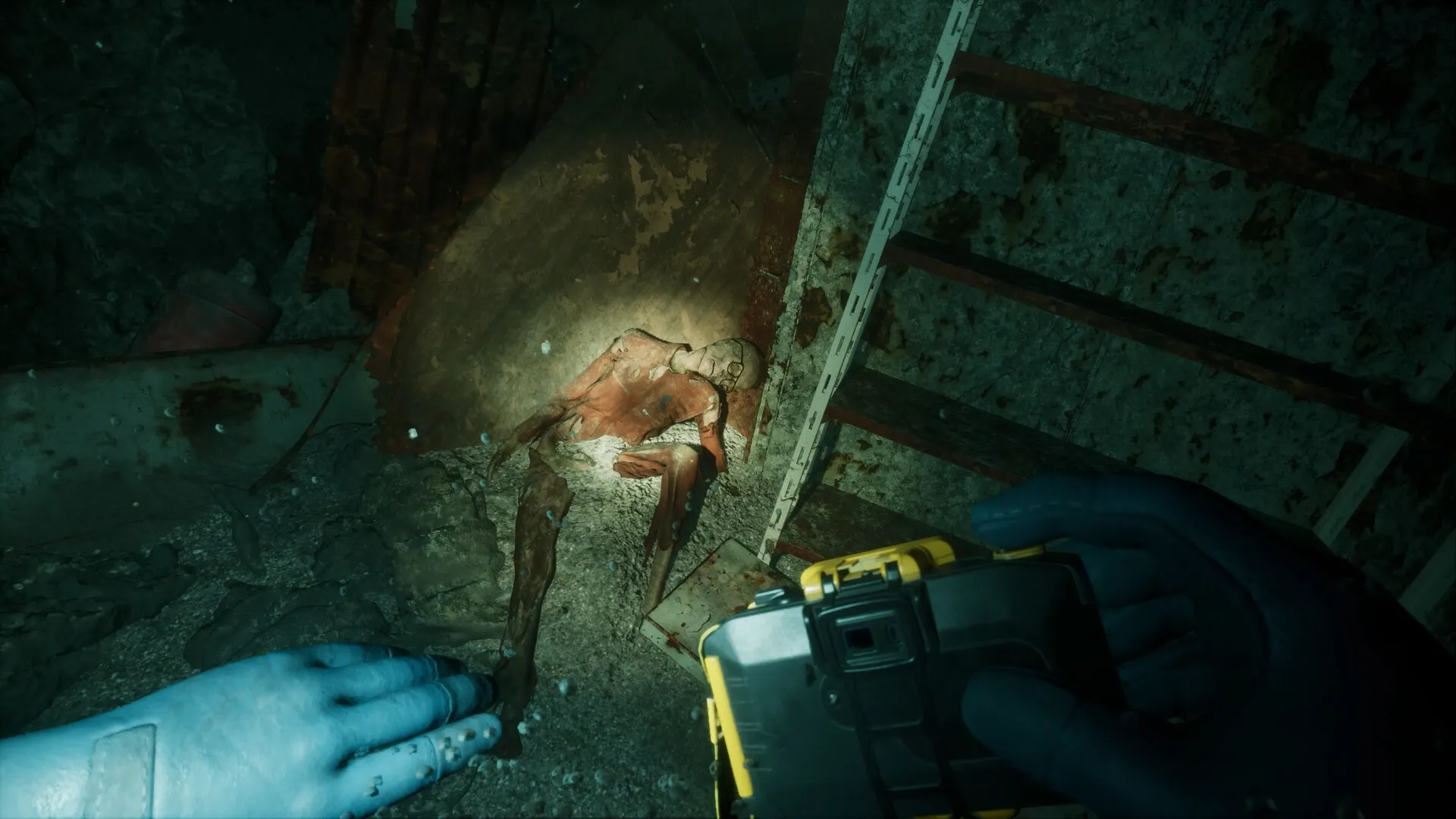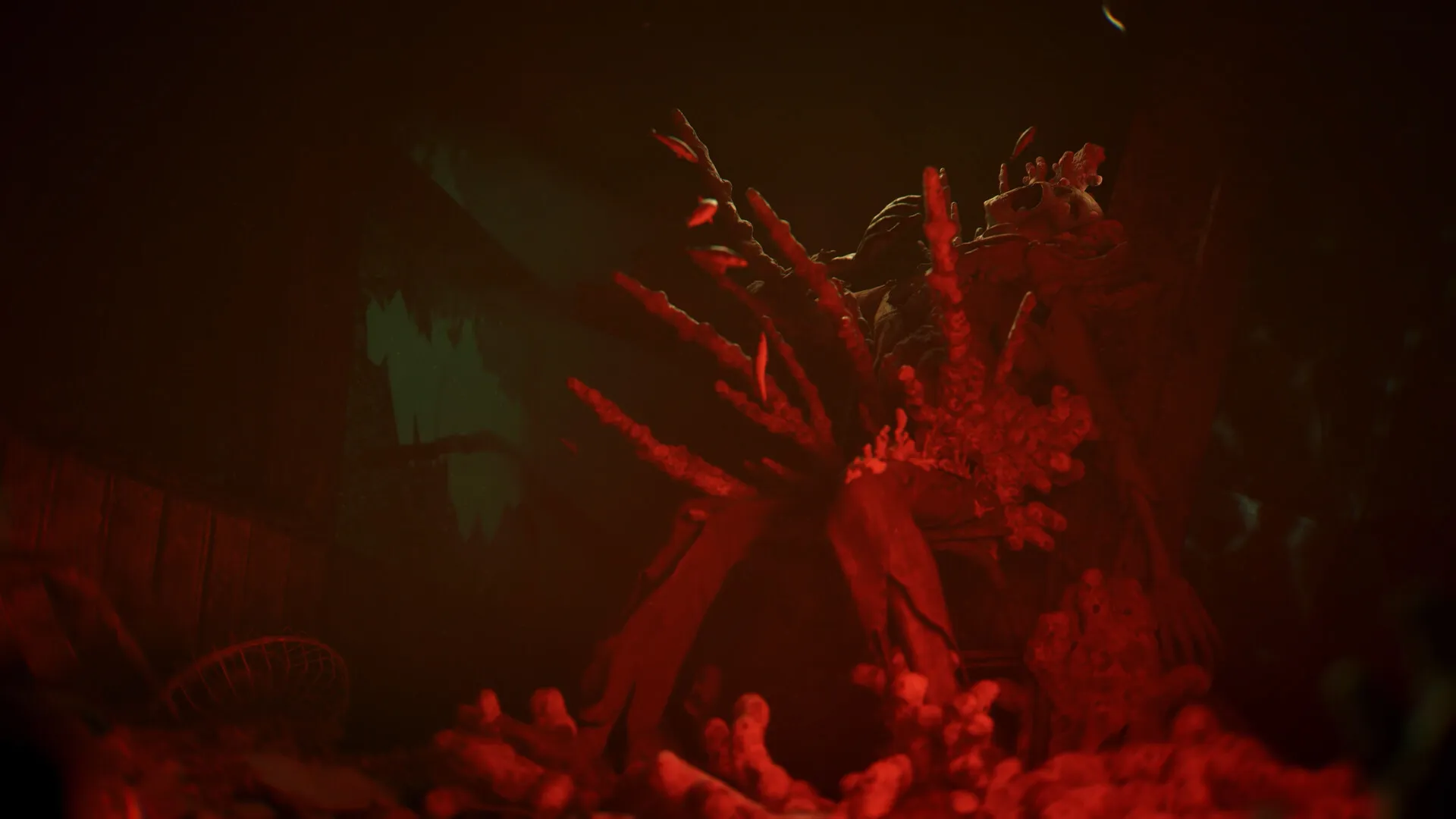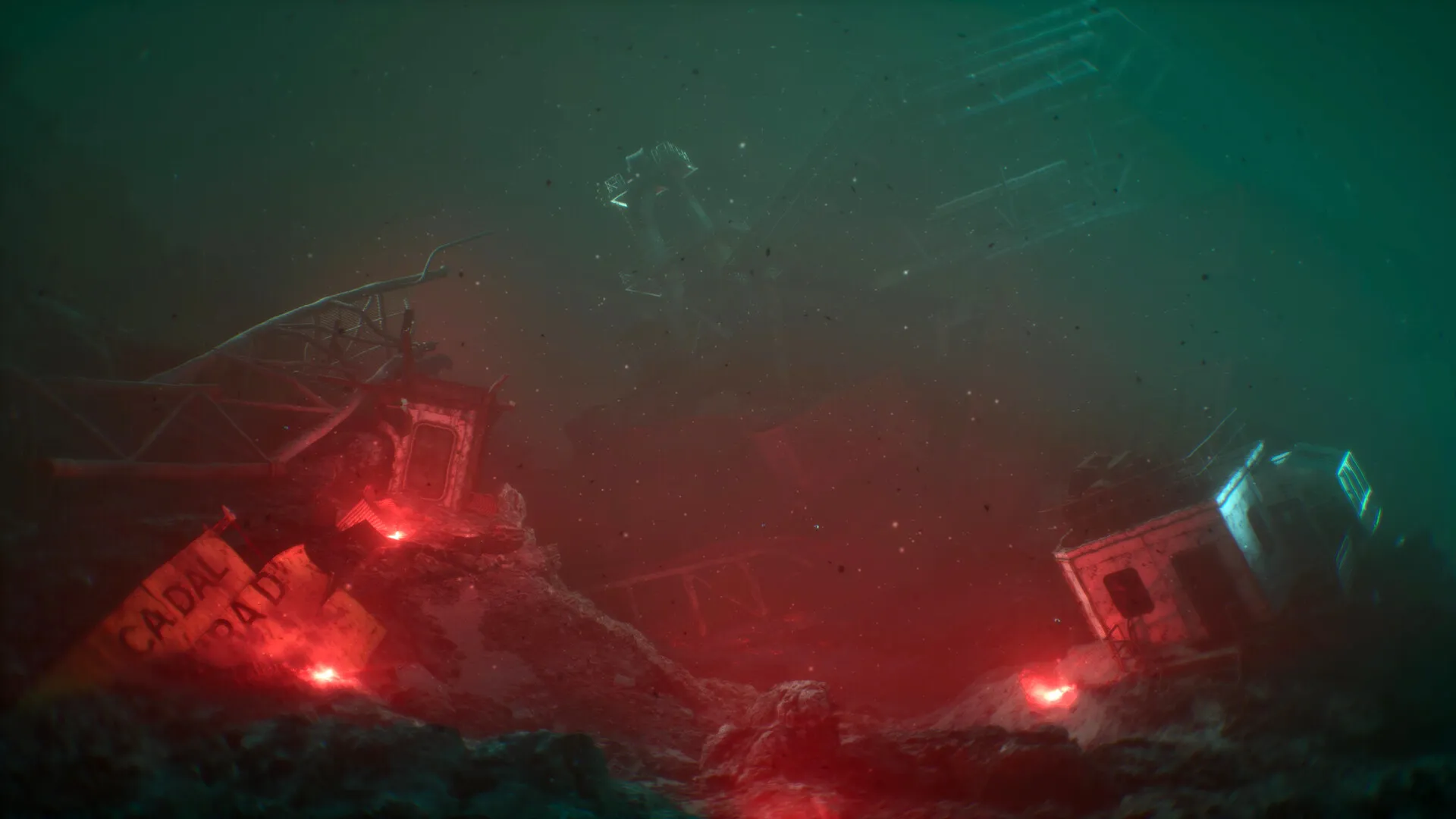Still Wakes the Deep: Siren’s Rest returns players to the half-ruined Beira D oil rig, now scattered across the North Sea floor over a decade after its catastrophic plunge. This paid expansion casts you as Mhairi, a saturation diver driven by personal loss and professional duty.
Equipped with an umbilical tether, a cutting torch, a crowbar, and a camera, she descends into murky wreckage to recover personal artifacts, document remains for grieving families, and extract the rig’s data recorder in pursuit of long-buried answers.
The DLC reconfigures familiar corridors into fractured, vertical environments, pushing exploration mechanics into more claustrophobic territory. Mhairi’s tether both guides and restricts her, creating tension when she’s forced to sever it and rely on limited reserve air. Light sources—flares and dive bell beacons—serve as waypoints through underwater darkness, while interactable objects stand out in OSHA yellow against rusted metal.
As an expert in narrative-driven design, it’s clear that Siren’s Rest interlaces its mechanics with emotional stakes: each recovered artifact reveals character backstory, and environmental puzzles echo the trauma of the wreck. The result is a survival horror experience that blends technical precision—streamlined tools and navigation aids—with moments of genuine uncertainty, demonstrating how gameplay systems can reinforce thematic weight without overwhelming the player.
A Sunken Mosaic of Memory and Fear
Beneath shifting currents and sediment lies the fractured skeleton of the Beira D, repurposed here as a three-dimensional labyrinth of discovery and dread. Siren’s Rest scatters the rig’s remains into modules half-buried in silt, inverted living quarters and collapsed walkways forming a patchwork of vertical shafts and submerged chambers.
These broken fragments echo the rig’s former layout—mess hall tables tipped on their ends, maintenance shafts now tight funnels—but reconfigure familiar spaces into new puzzle arenas. This approach mirrors how indie explorations like Soma and Subnautica reshape environments to maintain tension and player agency: you recognize home, yet must learn its contours all over again.
The soundscape transforms steel into an acoustic storyteller. Distant metallic groans punctuate near-silence, while constrained ROV chatter crackles through Mhairi’s comms. Occasional rushes of cold water remind you of an indifferent deep, and torchlight slices through murk to reveal OSHA-yellow lockers and control panels.
These bright waypoints ground you in an otherwise disorienting space—much like the navigation beacons in Void Bastards—which help balance exploration freedom against emotional immersion. When debris shifts under your weight or cables brush your helmet, the world feels alive and unpredictable.
Emotion rides every current. Returning players carry detailed memories of Caz’s original descent, introducing a layer of dramatic irony: you know where the rig collapsed, yet Mhairi’s first dive unveils each horror anew. This tension peaks in silent moments—an empty corridor, bubbles drifting toward a crushed doorway—before a distant clang reminds you of what sank here.
That interplay of anticipation and revelation creates emotional stakes akin to choice-driven RPG moments in indie titles like Oxenfree, where environmental whispers amplify character arcs. Here, however, it’s the landscape itself that speaks, weaving past and present into a cohesive tapestry of dread and remembrance.
Mechanics in Service of Mystery
Mhairi’s descent into Siren’s Rest hinges on fluid movement that balances the serenity of undersea travel with sudden disorientation. Swimming controls feel intuitive—forward momentum glides smoothly, strafing adjusts with believable inertia—but tight passages can become a tangle if you don’t manage your speed.
The umbilical tether ties you to a dive bell landmark, offering both reassurance and restriction. When clipped through walls or wrapping around debris, it highlights the lifeline’s presence, but these clipping quirks sometimes pull focus from immersion. Severing the tether creates a pulse of genuine tension: reserve air becomes a hard limit, transforming exploration into a calculated risk. This dynamic resembles the risk–reward loops in indie titles like Hollow Knight, where movement tools double as strategic constraints.
Interacting with the world feels tactile. The cutting torch slices through rusted gates with a satisfying spark and heat haze, echoing the precision of tools in RPGs like Disco Elysium that reward methodical use. Your crowbar and flaregun each carry scarcity: a handful of batteries power the torch, flares flicker out, and crowbar swings demand measured aim.
These resource limits reinforce narrative stakes—every locked hatch stands between you and closure for grieving families. By contrast, the camera offers narrative documentation rather than combat utility. It snaps personal artefacts and crew remains, embedding story fragments in photo logs. Yet the camera’s potential as a horror device feels underused; unlike Outlast’s constant threat gauge, here it simply archives, missing a chance to let players frame and confront the rig’s terror.
Environmental puzzles thread narrative into gameplay. Clearing rust not only unlocks pathways but symbolically strips away layers of forgotten trauma. Re-routing the umbilical through power conduits ties mechanical ingenuity to the urgency of Mhairi’s mission. Collectibles—handwritten letters, data logs, personal trinkets—are thoughtfully placed at emotional high points, so discovering Sunil’s statue or reading a supervisor’s distress message feels earned.
However, hunting down every item can stall momentum, similar to hidden-object segments in visual-novel hybrids that occasionally pull players out of tension. Siren’s Rest largely strikes a balance: puzzle complexity stays low enough for casual adventurers, while completionists will find enough depth to satisfy methodical playstyles without sacrificing narrative flow.
Voices from the Deep: Narrative Tension and Character Depth
Mhairi’s transformation from a focused saturation diver into a vulnerable investigator anchors Siren’s Rest’s narrative design. Initially, her professional composure—calibrating her torch, inspecting dataloggers—echoes structured RPG protagonists whose skill sets define early gameplay.
Beneath this surface lies a current of grief: each recovered trinket and photo log peels back her stoicism, revealing emotional fissures. Compared to Caz McLeary’s fiery resolve in the base game, Mhairi’s arc is quieter but layered; she reacts more than she defies, inviting players to read nuance in her measured dialogue rather than in overt branching choices.
Rob and Hans serve as narrative foils, their roles divided between remote guidance and on-site banter. Rob’s calm technical updates mirror voice-guided companions in indie explorations like Firewatch, placing trust in unseen allies. Hans’s quips, though occasionally warm, rarely transcend surface camaraderie—an echo of party NPCs in lighter RPGs whose dialogue loops without deepening bonds.
Their exchanges establish practical stakes and occasional levity, but the absence of real decision points means players witness rather than shape these relationships, missing opportunities seen in games like Oxenfree where conversational choices tangibly shift dynamics.
The story unfolds across three acts that mirror classical quest structures in narrative-driven RPGs. Act One invites methodical exploration—collect artefacts to piece together the tragedy’s human tapestry. Act Two escalates danger through environmental collapses and limited-air sequences, weaving pacing reminiscent of Disco Elysium’s tension spikes.
Finally, Act Three confronts the supernatural threat lurking in the wreck, forcing Mhairi to reconcile her professional purpose with personal catharsis. Narrative reveals—Sunil’s statue, Hans’s hidden audio log, visions of past crew—are strategically placed at mechanical milestones, ensuring that progression feels tied to emotional stakes.
Yet the DLC’s largely linear path limits real consequence. Decisions about which locker to prioritize may guide combatants to different logs first, but ultimately funnel back to the same revelations. This design trades choice granularity for story unity, favoring a curated emotional journey over player-driven divergence. It’s a narrative gamble that respects pacing but leaves those craving the weight of branching outcomes yearning for more agency as they navigate the rig’s silent corridors.
Echoes in the Deep
Still Wakes the Deep: Siren’s Rest demonstrates that visuals and audio aren’t mere embellishments but narrative conveyors in their own right. The DLC’s graphical fidelity brings the Beira D wreck to life with painstaking detail: rust flakes off bulkheads, corroded pipes sprout marine growth, and sediment drifts through low-pressure zones.
Dynamic lighting underscores this realism—flarelight dances across twisted metal, dive bell lamps carve out pockets of safety, and deep shadows hint at unseen chasms. Moments atop the vertical abyss feel like standing on the edge of an underwater cliff, while air pocket sanctuaries glow with an almost sacred calm. These setpieces rival the environmental storytelling of indie hits like INSIDE, where every visual cue deepens immersion without a single line of dialogue.
Audio design in Siren’s Rest weds technical precision to emotional weight. The rush of displaced water against Mhairi’s helmet becomes a constant reminder of pressure and vulnerability, while metallic groans and umbilical whines layer tension beneath the surface. Contrasting minimal ambient undercurrents with sudden crescendos—akin to the sparse score in RPGs like Disco Elysium—heightens unease just when exploration feels safe. Voice performances, particularly Mhairi’s measured Scottish accent and Rob’s clipped updates, sound bespoke rather than recycled, grounding each comms exchange in lived experience.
Horror in Siren’s Rest leans heavily on silence and environmental audio. Lulls in sound—an empty corridor, a slow drip—set the stage for supernatural cues: distant, unplaceable thuds or a subtle harmonic drone that suggests something prowling just out of sight. However, occasional overuse of abrupt orchestral hits undercuts this tension, echoing the missteps of larger-budget titles that trade subtlety for jump scares.
A missed opportunity lies in the tether’s soundtrack: a rhythm or heartbeat sound when Mhairi detaches could have amplified the lifeline’s narrative significance. Still, when silence and sound blend seamlessly, Siren’s Rest achieves an unsettling intimacy, reminding players that beneath these audio layers lies a story of loss waiting to be heard.
Currents of Momentum
In the opening act, Siren’s Rest grants players room to breathe before the weight of tragedy settles in. Mhairi’s tether links her to a stationary dive bell, enabling relaxed exploration as you chart halls strewn with personal effects. This freedom echoes the early rhythm of indie exploration games like Tacoma, where players reconstruct events at their own pace.
Collectible artefacts and data logs dot the environment, rewarding curiosity with character insights—but too many hidden nooks can stall forward momentum, particularly for players accustomed to tighter progression loops found in RPGs such as Disco Elysium.
Midway, the DLC accelerates into mechanical and emotional urgency. Structural failures trap Mhairi in twisting wreckage, forcing detachment from her lifeline and initiating limited-oxygen gameplay. These moments resemble survival spikes in Darkwood, where resource scarcity amplifies fear.
Chase sequences and collapsing corridors punctuate exploration, turning methodical searching into a race against fading air. Here, mechanical constraints—torch battery life, tether length—mirror narrative stakes, as each forced decision to push onward or retreat reflects Mhairi’s drive for answers despite mortal peril.
As the narrative hurtles toward its climax, pacing becomes noticeably compressed. The final act layers supernatural reveals atop crumbling metal, threading tension through faster transition between encounters. This mirrors act-three escalation in RPGs like The Banner Saga, where story beats accelerate to meet thematic crescendos.
Yet the condensed runtime—approximately three hours in full completion—leaves these revelations feeling rushed. Emotional setpieces arrive back-to-back, granting vivid jolts of grief and dread but offering little breathing room for their impact to resonate.
Ultimately, Siren’s Rest uses pacing as a narrative tool: leisurely discovery gives way to harried desperation, reflecting Mhairi’s descent from professional detachment to raw vulnerability. While occasional lulls in hidden-object segments temper that rise, the shift from calm to chaos underlines the game’s thematic currents, reminding players that sometimes uncovering the truth demands riding a surge rather than standing on the shore.
Under the Hood—Performance and Worth
Siren’s Rest runs on familiar foundations, yet technical hiccups puncture its immersion. The umbilical tether occasionally clips through walls or trails awkwardly, and flares can stick in midair after use. Dialogue lines sometimes overlap when exploring non-linearly, and a handful of users have reported rare crashes on consoles.
Despite these glitches, the DLC maintains stable frame rates and rapid load times across PC, PlayStation, and Xbox—patches have already addressed some early showstoppers, smoothing out most faults without compromising visual fidelity.
Clocking in at roughly two to three hours for a full playthrough, Siren’s Rest offers modest replay value beyond collectible hunting or speed runs. Its price point—around $12–15—positions it among bite-sized narrative expansions, rewarding those invested in the Beira D’s lore but potentially underwhelming for newcomers seeking prolonged engagement. The balance tilts in favor of fans eager for closure, rather than players looking for extended survival mechanics.
Atmosphere, narrative stakes, and the novelty of underwater exploration emerge as standout elements, while brevity and occasional pacing jolts remind us of the DLC’s focused scope. Technical rough edges momentarily surface, yet they rarely derail tension entirely. For those who found Still Wakes the Deep’s mysteries compelling, Siren’s Rest deepens the emotional current—if only briefly—before the rig’s shadows settle once more.
The Review
Still Wakes the Deep: Siren’s Rest
Siren’s Rest plunges players back into the Beira D’s haunted remains with immersive visuals, tense mechanics, and meaningful artifact-driven storytelling. Though its three-hour runtime and intermittent technical hiccups dilute momentum, the expansion delivers a poignant, atmospheric dive that strengthens the base game’s emotional resonance.
PROS
- Rich underwater atmosphere
- Tactile tool interactions
- Emotional artefact discoveries
CONS
- Short overall length
- Occasional clipping and glitches
- Abrupt narrative pacing




















































